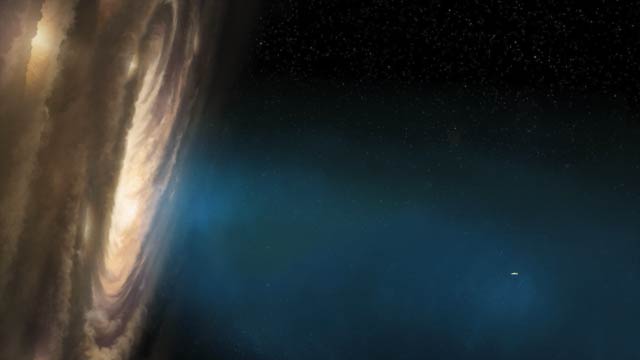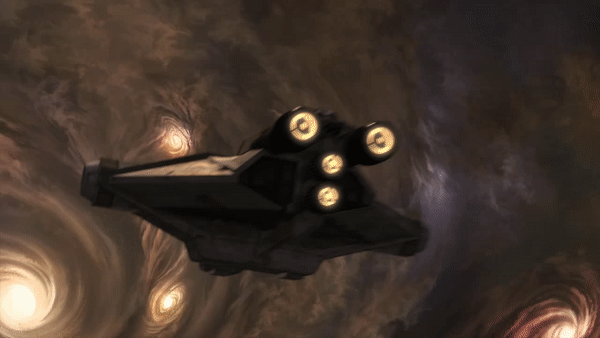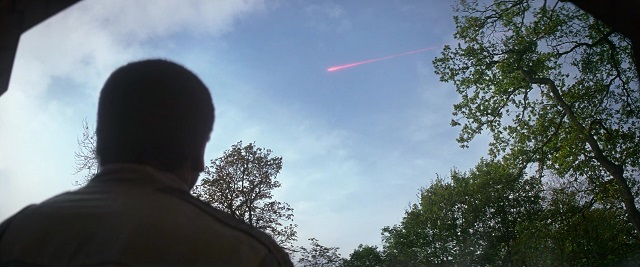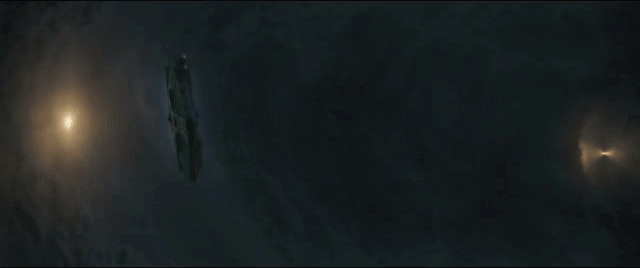
The Solo film is approaching fast, with our first canonical look at the Kessel Run that made the Millennium Falcon famous. We have multiple confirmations now that the Kessel Run is made hard to navigate by black holes in the vicinity, among other things, and this wouldn’t be the first time the new canon has shown this kind of environment as a navigational hazard. Indeed, the heroes of Star Wars Rebels faced such phenomena in their journey through a star cluster, in the second season episode “Legends of the Lasat”.
Black holes and their surroundings are the topic of the astrophysics research I do for a living, so I’ve wanted to talk about this since before I finished writing about Concord Dawn. Because I absolutely loved this scene. Accompanied by the marvelous music of Kevin Kiner, magnificent visuals depict a maelstrom of gas and dust that swirls around a number of bright, hotter spots where the black holes whose gravity dominates the entire region might be located, but they are left unseen. Indeed, the fun thing about these objects is how small and compact they are compared to their mass: the spherical event horizon of a black hole as heavy as our entire Sun would be a bit less than six kilometers wide. When the camera in the episode is pointed sideways, away from the accreting dust, blue streams of ionized gas can be seen coming out of the biggest hot spots. Some in-falling, disintegrating objects, probably asteroids disrupted by tidal forces, complete the picture. I liked it so much that I remarked at the time how, given its description in Legends sources, this could have been a great depiction of the Maw, the black hole cluster located near the Kessel Run.
But there was more. Despite the term “black hole” appearing in concept art, Hera says “imploded star” instead. They probably changed it to make it sound more exotic, but in doing so they actually increased its accuracy! The explanation is as follows. Natural ways to end up with a cluster of black holes involve massive stars exploding as supernovae. Stars tend to form in clusters, and the heavier they are, the faster they burn their fuel and the shorter they live, so massive stars don’t get very far from each other before dying. And if some of these had more than twenty-five times the mass of the Sun, they could leave black holes behind as their cores collapse (or implode). However, the formation of those stars will also produce many more of lower masses. The ones with more than eight times the mass of the Sun will live a few million years longer and their cores will also implode, but this time creating neutron stars. You would also expect some of these in a cluster of black holes like this, and “imploded star” includes both.
Such a cluster, by the way, could also have been the center of a tiny galaxy that was cannibalized by the Galaxy Far, Far Away eons ago, having encountered this gas and dust nebula only in the last millennium. I mention this because in the core of such a small ancient galaxy, or in a globular cluster, objects get redistributed by gravity and the heaviest ones (among them black holes from five to tens of times the mass of the Sun) accumulate near the center. That way, they could end up as close to each other as we see in the episode (in our own Milky Way, we think there are more than ten thousand black holes within three light years of the supermassive one at the center. That’s closer than the distance from the Sun to its nearest star).

This deadly environment dragged our heroes out of hyperspace when they were trying to reach the prophesied planet Lira San on the other side. Chased by the Empire, they are forced to flee towards the cluster itself, with the Force as their ally and guide. Flowing through Zeb’s bo-rifle, a mysterious field is generated that protects the Ghost from the powerful tidal forces of the black holes, and eventually activates the ship’s hyperdrive with a safe route towards Lira San though the maze of singularities. The pursuing TIEs are not so lucky—they vanish as gravity completely disrupts them. The scene still gives me goosebumps every time I rewatch it.
Some of the events in it also remind me of something from the now-Legends New Jedi Order series of books. There, New Republic pilots increased the power and range of the inertial compensators in their starfighters to protect them from an enemy capable of generating micro black holes, and I wonder if the bo-rifle worked through the inertial compensators of the Ghost to protect it in a similar manner (we saw it activate the hyperdrive, after all). But either way, it looks like the gravitational field is less intense in the Ghost‘s surroundings than in the rest of the region, which might be causing the laser bolts from Kallus’s cruiser to deflect away from the ship and towards regions of higher gravity.

If I had to point out possible flaws with the scene, it might only be the way the TIE fighters are disintegrated (the concept art of this moment is more realistic, I think). But all in all, I was really happy with the physics in this episode. Its science would be addressed in the following week’s Rebels Recon when Pablo Hidalgo answered an audience question about it:
“We saw the crew near a black hole, so are we going to see the time dilation suffered by them?“
My mind was racing for the answer even as I read it. Because, you see, the question stems from a really common misconception about black holes: that just the presence of one means the time dilation is going to be very large. But the truth is that, for the effect to be very noticeable, you’d have to be much closer to it than people normally expect. For example, in the case of a black hole ten times as massive as the Sun, you’d need to be just 140 km above the event horizon to get only a ten-percent time dilation. And the event horizon of such a black hole is already a sphere almost 60 km wide, so the gravitational lensing effects would be large and already quite noticeable (think of the black hole depiction in Interstellar, which is not what we see in Rebels). For a black hole twice as heavy you’d have to be at twice the distance but the event horizon would also be twice as large, so for the same time dilation its appearance will not change.
But let’s suppose for a moment they did pass that close to one of the black holes. A time dilation of ten percent means that even if the Ghost had spent an entire hour at that distance, the crew would have lost only six minutes with respect to the outside world. So the effect would have been very tiny in this episode, and that’s not counting that the Force ritual protecting the ship from the gravity field could have protected it from the time dilation as well. There wasn’t really an issue with time here, and I expected Pablo to say as much. This was his answer:
“You’re getting science into our Star Wars, which is always kind of a weird thing. We don’t know for sure whether or not the Star Wars galaxy experiences physics or time the same way our galaxy does. In Star Wars there’s like, simultaneity, it’s called. They have objective time. That is, someone on Tatooine can experience a Tuesday, and someone on Coruscant is experiencing that exact same Tuesday, can pick up the phone and call them. That doesn’t happen in our galaxy because of relativity. The rules are different so… who knows what happens when you fly close to a star cluster like that.“
Um.
Well, given how happy I was with the scientific accuracy of the scene, I must confess that I didn’t expect him to dismiss the entirety of relativistic physics in Star Wars! He’s right, of course, that in our universe there’s no objective time and the simultaneity of two distant events depends on your frame of reference. But in Star Wars this is usually circumvented through the use of technology that allows for faster-than-light travel and communication, and compensates for the relativistic effects that would be cumbersome in a galaxy-wide civilization (at least when it works properly). One would expect that, were those technologies not available, physics would still apply as it does in the real world.
And here I’d like to say a few words about the Legends books that comprise the Corellian Trilogy, perhaps the most respectful of physics of all the Star Wars stories I’ve come across, because (spoilers ahead!) one of its main plot points is precisely this. At one point, an entire star system is affected by an interdiction and jamming field that prevents faster-than-light communications and travel. Without hyperspace all the way in, ships took weeks or months to reach the inner part of the system from outside. Messages sent using plain old radio waves made conversations excruciatingly slow, as they would take hours to be received at the destination. That story illustrates how hard life would be in the Star Wars galaxy without these technologies that are taken for granted, and how real-world physics can be seamlessly integrated with them and even enhance the narrative.

The first film of the new canon, however, seemed to throw relativity out of the window by making the destruction of Hosnian Prime visible in the skies of Takodana, half a galaxy away. But instead of making me abandon all hope of reconciling physics and Star Wars, canon sources have shown that this was a special case. Besides a comic with Leia reflecting on how Alderaan is still there when looking at its star from other systems (since the light from the explosion hasn’t reached them yet), in the book Cobalt Squadron we get a great look at how the rest of the galaxy experienced Hosnian Prime’s destruction. When speculating about those lights in the sky and the electromagnetic disturbances that came with them, the lightspeed limit is always taken into account. Some are convinced it was a solar flare; others, light from an old supernova that’s only then arriving in their system. The effects are stronger in hyperspace, probably meaning that light from the event, caused by Starkiller Base through hyperspace itself, also traveled through it towards the rest of the galaxy. Thus the conflict with known physics was greatly alleviated.
But I want to be clear on this—none of that means that Pablo’s answer was wrong. Even if I preferred a different approach in that particular instance, all these explanations invoking hyperspace or subspace technology as just an “apparent” disagreement with science only work if those dimensions are allowed by real-world physics. Which they might not be! And if that is the case, the rules in Star Wars are indeed different. If something doesn’t match our science, it does not mean it is “wrong” as long as it’s consistent with them.
What does this all mean for Solo? This episode of Rebels might be relevant when considering that when Kanan was exposed to the vacuum of space, they made sure to clarify in Rebels Recon that it was in fact survivable, perhaps to prepare audiences for when Leia found herself in a similar predicament in The Last Jedi. “Legends of the Lasat” could serve a similar preemptive purpose, given what we currently know of the Kessel Run, and especially now that the Maw itself is mentioned in the tracklist for the movie’s soundtrack. Will we get a view of black holes in a Star Wars production on the big screen for the first time, perhaps with extra weirdness added to the mix? Not a long wait to find out!

